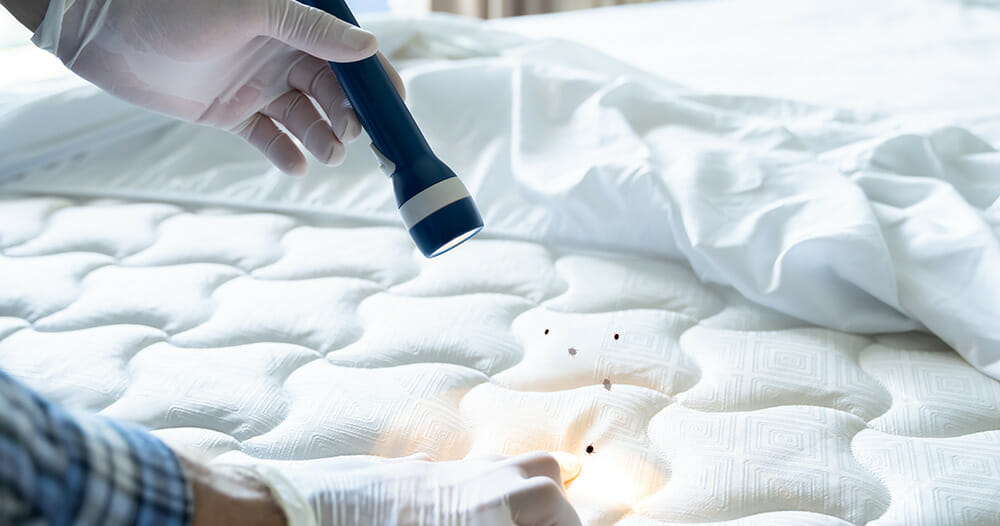Bed bugs can be an incredibly frustrating experience if they manage to take up residence in your home. These tiny pests are about the size of an apple seed and reddish brown in color — but it’s pretty unlikely you’ll spot an actual bed bug unless you know what to look for. Knowing what causes them and early signs of an infestation is the key to keeping their numbers under control. In this post, we will examine some myths about where bedbugs lurk most often and provide advice on avoiding and treating an infestation should you face one in your own home.

Common Myths about Where Bed Bugs Come From
Bed bugs can be present in any residence or business, regardless of how clean or luxurious it may be. An infested environment isn’t necessarily affiliated with poor hygiene as many may assume. Bed bugs seek out human hosts for sustenance—they don’t discriminate!
Bed Bugs and Cleanliness
Even the most meticulously cared-for homes can be affected by bed bugs. While many pests gravitate to specific environments, bed bugs aren’t selective about where they live. They’ll hitch rides and set up camp anywhere they can find a blood meal on mattresses — so long as they have a steady food supply, they are remarkably hardy. Contrary to popular belief, being clean doesn’t make you less vulnerable to a bed bug infestation. That said, by regularly changing your sheets and tidying up, you may notice a potential infestation more quickly.
Bed Bugs and Seasonality
No matter the season, bed bugs can thrive indoors. These tiny creatures tend to become most active during warmer months. Still, they can survive harsh winter conditions by entering diapause, the insect equivalent of hibernation. You may notice an uptick in bed bug activity globally during peak travel times — summer in the United States and the holiday season can get nasty if hotels and motels aren’t vigilant about checking for bed bugs.
Common Sources of Bed Bug Infestations
Bed bugs move from place to place by hitching rides. These pesky insects do not possess wings and are incapable of flying or jumping. However, they can crawl and hide in tiny crevices. Bed bugs often latch onto clothing, luggage, or personal belongings, taking advantage of the opportunities presented by human movements.
Traveling can bring these bugs into your house via clothing or personal belongings like luggage. Secondhand furniture might contain them as well, and if you use public transit regularly, that could act as an entry point for such pests, too. If you stay vigilant, you can stop an infestation in its tracks.
Travel-Related Infestations
Bed bugs are a significant concern for travelers. They commonly infest hotels, motels, and even cruise ships, biting guests in their sleep at best and hiding away in luggage at worst. Suppose a traveler picks up bed bugs on vacation. In that case, they may go undetected until they take up residence at an entirely new location. Bed bugs can swiftly and inconspicuously relocate, leading to infestations in new areas.
Second Hand Furniture Risks

When buying second hand furniture, be mindful of bed bugs that may be hiding in or on the items. Be
fore bringing any used furniture inside, perform a detailed examination, looking for bed bug droppings, bed bug eggs, and live insects.
Public Transit Encounters
It is possible to transport bed bugs from public transit onto your clothing and belongings, though this is rare. To avoid accidentally picking up bed bugs on public transportation, check your seat before sitting down, and avoid placing your belongings on the ground.
Bed Bug Habitats: Where They Hide and Thrive
These nocturnal parasites tend to emerge at night when people are sleeping so they can enjoy a blood meal undisturbed. If you’re going to identify bed bugs, thoroughly and frequently inspect areas where they prefer to hide.
Bed bugs can often be found in crevices of mattresses, box springs, and bed frames. They like to stay close to their food source, and furniture provides plenty of tiny cracks bed bugs that can live undetected. Bed bugs are so small that they can even hide inside the mattress itself. Other upholstered furniture, like coaches, headboards, and chairs can also harbor bed bugs.

Want a professional opinion?
Schedule a free inspection!
Prevention Strategies for Homeowners and Renters
To keep your home from bed bugs, perform routine inspections and stay vigilant when traveling. If you know what to look for, you can spot the tell-tale signs of bed bugs and avoid bringing them to your home.
Regular Cleaning and Inspection
Organizing your home and removing potential hiding spots for bed bugs are a few ways to help avoid an infestation. A clean house also makes it easier to spot when something looks out of place since the surrounding area is neat. Consistently inspecting and cleaning your mattress and box spring when you make the bed can clue you in to signs of a potential infestation before it gets too severe.
Travel Precautions
If you’re traveling, protecting yourself from bed bugs is essential. Once you check in to your room, inspect areas bed bugs commonly hide, like your bed frame, mattress, headboard, and linens. Keeping your luggage off the floor can also help you avoid bringing bed bugs home with you if there is an infestation you missed during your room check.
What to Do If You Have a Bed Bug Infestation
When there is an indication of a bed bug issue, take action to get rid of bed bugs at the first sign of an infestation. Whether you spot evidence of these pests in your home or on the road, a prompt response can help contain an infestation.
Report Infestations in Hotels and Apartments
If you find bed bugs while traveling, or if you’re living in an apartment complex and you think you have bed bugs in your unit, notify the property manager as soon as possible. In an environment where lots of people are constantly in and out, bed bugs can spread rapidly. When reporting an issue, provide exact details and photos when possible of where you’ve seen bed bugs or signs of bed bugs.
Clean What You Can
If you have a bed bug infestation in your home, start by stripping your bed and washing all your linens on high heat. The hot water will kill any adult bed bugs. You can also use a steam cleaner and vacuum on upholstered surfaces to try to capture and kill live bed bugs. This won’t necessarily rid your home of an infestation, but you can at least get a jump start getting rid of these tiny pests while you wait for professional intervention.
Seek Professional Pest Control
While you can try to get rid of bed bugs on your own, you’ll see the best results from a professional pest control company. Bed bug exterminators know how to diagnose and remediate an infestation quickly. Dodson Pest Control has been in business for over 75 years, and our team of professionals is highly familiar with the behavior of bed bugs. No two situations are the same, and that’s why we always offer free inspections so we can develop a custom bed bug treatment plan to tackle your infestation for good.
Find a Dodson Location Near You!
Frequently Asked Questions
Bed bugs can quickly be introduced into a place by hitching rides in handbags, suitcases, and clothing, so any infestation that appears out of nowhere likely came from the outside.
Bed bug infestations can occur anywhere people or animals are present, regardless of the level of cleanliness. Prompt identification and treatment are important to keep them under control. These creatures do not choose between tidy and untidy places. Rather, they may be found on any bed – from immaculate upholstery to messy mattresses.
It’s possible to identify a bed bug infestation through a few tell-tale signs, including rusty-colored stains on mattresses and sheets, black spots that may leave marks on fabric, visible eggs or eggshells, an unpleasant musky odor, and bite marks. If you suspect a bed bug infestation, request a consultation from a professional to confirm.
Bed bugs can be found all year round, having no specific season.
